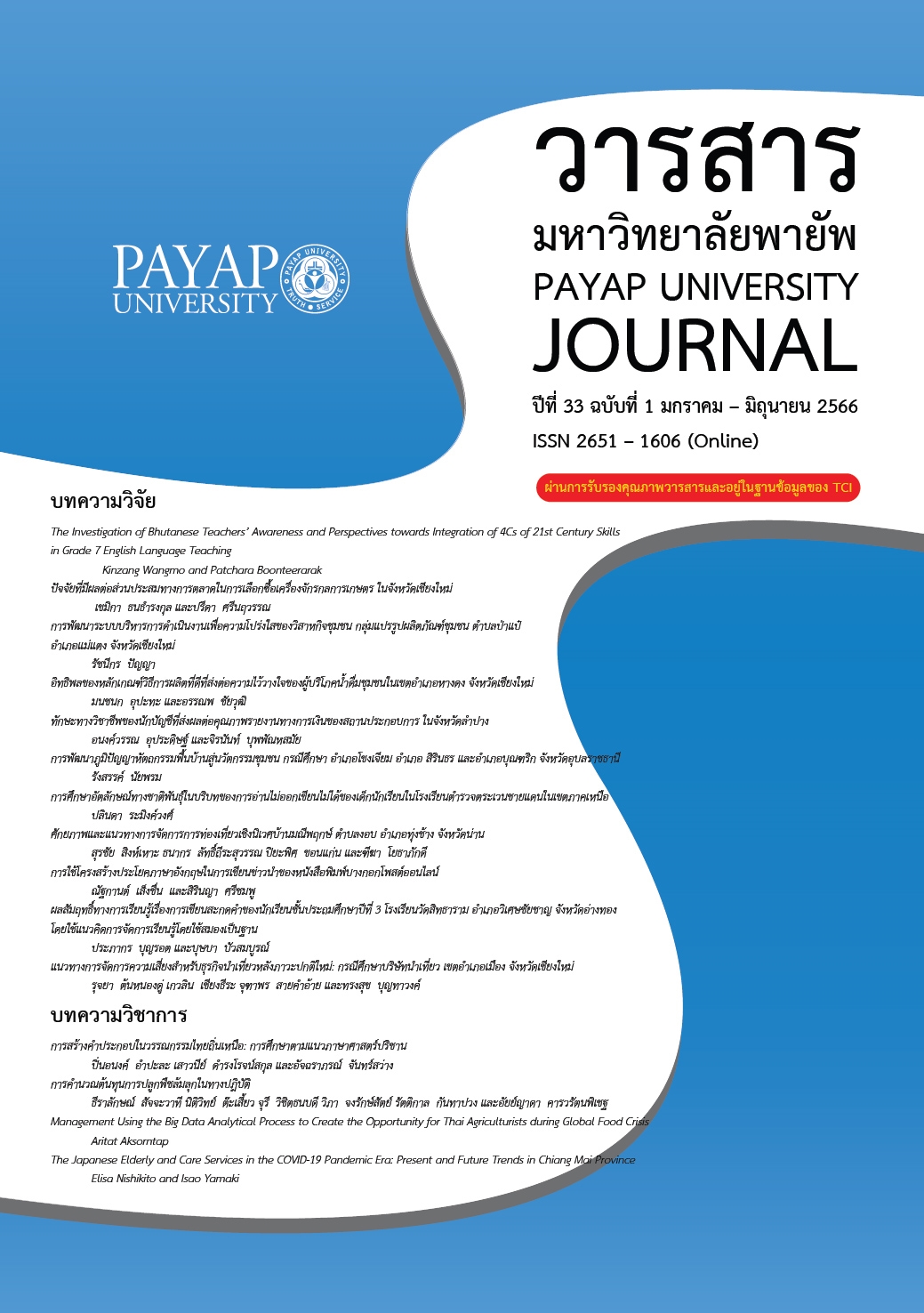การสร้างคำประกอบในวรรณกรรมไทยถิ่นเหนือ: การศึกษาตามแนวภาษาศาสตร์ปริชาน
Main Article Content
บทคัดย่อ
การศึกษาการสร้างคำประกอบในวรรณกรรมไทยถิ่นเหนือตามแนวภาษาศาสตร์ปริชาน มีวัตถุประสงค์เพื่อวิเคราะห์ลักษณะคำประกอบในวรรณกรรมไทยถิ่นเหนือ โดยวิเคราะห์จากเรื่อง คร่าวหงส์ผาคำ ค่าวซอนกกระจาบ และค่าวซออ้ายร้อยขอด ปรากฏลักษณะดังนี้ ลักษณะแรกคำประกอบที่เกิดขึ้นมาจากพื้นที่ 1 เคลื่อนที่เข้าไปในพื้นที่ 2 ความหมายที่เกิดขึ้นยังคงความหมายของคำในพื้นที่ 1 ลักษณะต่อมาคำประกอบที่เกิดขึ้นมาจากคำในพื้นที่ 2 เคลื่อนที่เข้าไปคาบเกี่ยวกับคำ ในพื้นที่ 1 ความหมายที่เกิดขึ้นยังคงความหมายของคำในพื้นที่ 1 ลักษณะที่สามคำประกอบที่เกิดขึ้นมาจากพื้นที่ 1 และพื้นที่ 2 เคลื่อนที่ความหมายเคลื่อนที่เข้าไปรวมกันความหมายที่เกิดขึ้นเปลี่ยนไป จากความหมายเดิม ลักษณะสุดท้าย คำประกอบที่เกิดขึ้นมาจากพื้นที่ 1 และพื้นที่ 2 เคลื่อนที่เข้าไป ทับกันสนิทไม่มีช่องว่าง ความหมายที่เกิดขึ้นไม่ปรากฏความหมายเดิม และยังมีความหมายเป็นอุปลักษณ์ จากผลการวิเคราะห์แสดงให้เห็นถึงมโนทัศน์พื้นที่ทางความหมาย การเคลื่อนที่ทางความหมาย และกระบวนการดังกล่าวจะช่วยทำให้เห็นความหมายของคำที่เกิดใหม่ ไม่ว่าจะเป็นการขยายพื้นที่เดิม หรือการเกิดความหมายเชิงเปรียบเทียบ และกระบวนการขยายออกไปจากความหมายเดิม
Article Details
เอกสารอ้างอิง
ปัญญา. (2511). ค่าวนกกระจาบ. ประเทืองวิทยา.
สถาบันราชภัฏเชียงใหม่ สถาบันภาษา ศิลปะและวัฒนธรรม. (2550). พจนานุกรมภาษาล้านนา. แสงศิลป์.
อุดม รุ่งเรืองศรี. (2524). คร่าวซอหงส์ผาคำของพระยาโลมาวิสัยฉบับเทียบอักษรลานนาไทย. คณะมนุษยศาสตร์ มหาวิทยาลัยเชียงใหม่
อุดม รุ่งเรืองศรี. (2547). พจนานุกรมล้านนา-ไทย ฉบับแม่ฟ้าหลวง ตอนที่ 1-2. อมรินทร์พริ้นติ้งกรุ๊ป.
อุ่นเรือน. (2511). ค่าวอ้ายร้อยขอด. ประเทืองวิทยา.
Benczes, R. (2006). Creative compounding in English: The semantics of metaphorical and metonymical noun–noun combinations. John Benjamins Publishing Company.
Johnson, M. (1987). The body in the mind. The University of Chicago Press.
Lakoff, G and Johnson, M. (1980). Metaphors we live by. The University of Chicago Press.


